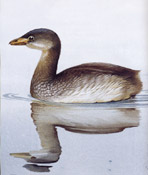A Gap in Nature
Air Date: Week of October 24, 2003
In another installment of our continuing series on animals that are no more, author Tim Flannery tells us about the Atitlán grebe, a nearly flightless bird that once lived in the Guatemalan highlands.
Transcript
CURWOOD: There is a convention in biology that says before a species can be declared extinct one must wait fifty years after a last sighting. But some animals have such a small distributions that their extinction is quickly obvious. Such was the case with the Atitlán grebe that inhabited only one place on earth, Lake Atitlán in the Guatemalan highlands. This nearly flightless bird likely had been cruising the waters of Lake Atitlan probably since before the last ice age. But as Tim Flannery explains in the latest installment of our series, “A Gap in Nature,” a number of factors led to the birds’ demise.
[MUSIC: Unknown Artist “Gap In Nature Theme Music” UNKNOWN ALBUM (Unknown Label – Year)]
FLANNERY: The Atitlán grebe was smaller than its distant cousin, the loon. Until about 1965 this dark-colored bird had a relatively stable population of around 800. But soon after that, both small and large mouth bass were introduced into the lake, and these voracious predators ate so many crabs and fish that little was left for the grebe.
 Atitlán Grebe (Illustration: Peter Schouten)
By 1975 the grebe population had plummeted by 75 per cent and although a conservation program was mounted to try to save the bird, other changes were afoot that would destroy them. The bird’s breeding habitat was being removed by reed cutters. To add insult to injury, the lake was being invaded by another competitor: a smaller, related bird known as the pied-billed grebe. Atitlán Grebe (Illustration: Peter Schouten)
By 1975 the grebe population had plummeted by 75 per cent and although a conservation program was mounted to try to save the bird, other changes were afoot that would destroy them. The bird’s breeding habitat was being removed by reed cutters. To add insult to injury, the lake was being invaded by another competitor: a smaller, related bird known as the pied-billed grebe.
In the late 1970’s, researchers surveyed how many Atitlán were left by playing a recording of the night-time breeding call of the male. Any male Atitlán hearing this call would respond, and from that, scientists should have been able to estimate the number of breeding pairs still left. The trouble was, the calls of the pied-billed and Atitlán grebes were very similar. What’s worse, the researchers did not even know that the pied-billed grebe had invaded the lake. So the rosy results of the sound survey made it seem like there was a healthy population of Atitlán grebes. That is, until one day, when the researchers approached some of the birds– which to their horror flew away. The scientists realized they had been counting the wrong birds – not the flightless Atitlán, but its smaller, flighted pied-billed relative. Unlike the Atitlán grebe, the invading pied-billed grebe found the degraded lake much to its liking, and by the mid-1980s it was breeding there year-round. It may have even mated with the Atitlán, producing hybrids. In any case, by 1989 just two pairs of giant Atitlán grebe inhabited the lake, and none have been seen since. CURWOOD: Tim Flannery is author of “A Gap in Nature: Discovering the World's Extinct Animals”. To see a picture and hear the call of the Atitlán grebe and other ex-animals go to our website livingonearth.org. That's livingonearth.org. [MUSIC: Kevin Shields “Are You Awake” LOST IN TRANSLATION (Emperor Norton-2003)] Links
– The call of the Atitlán grebe. (mp3)"> |





